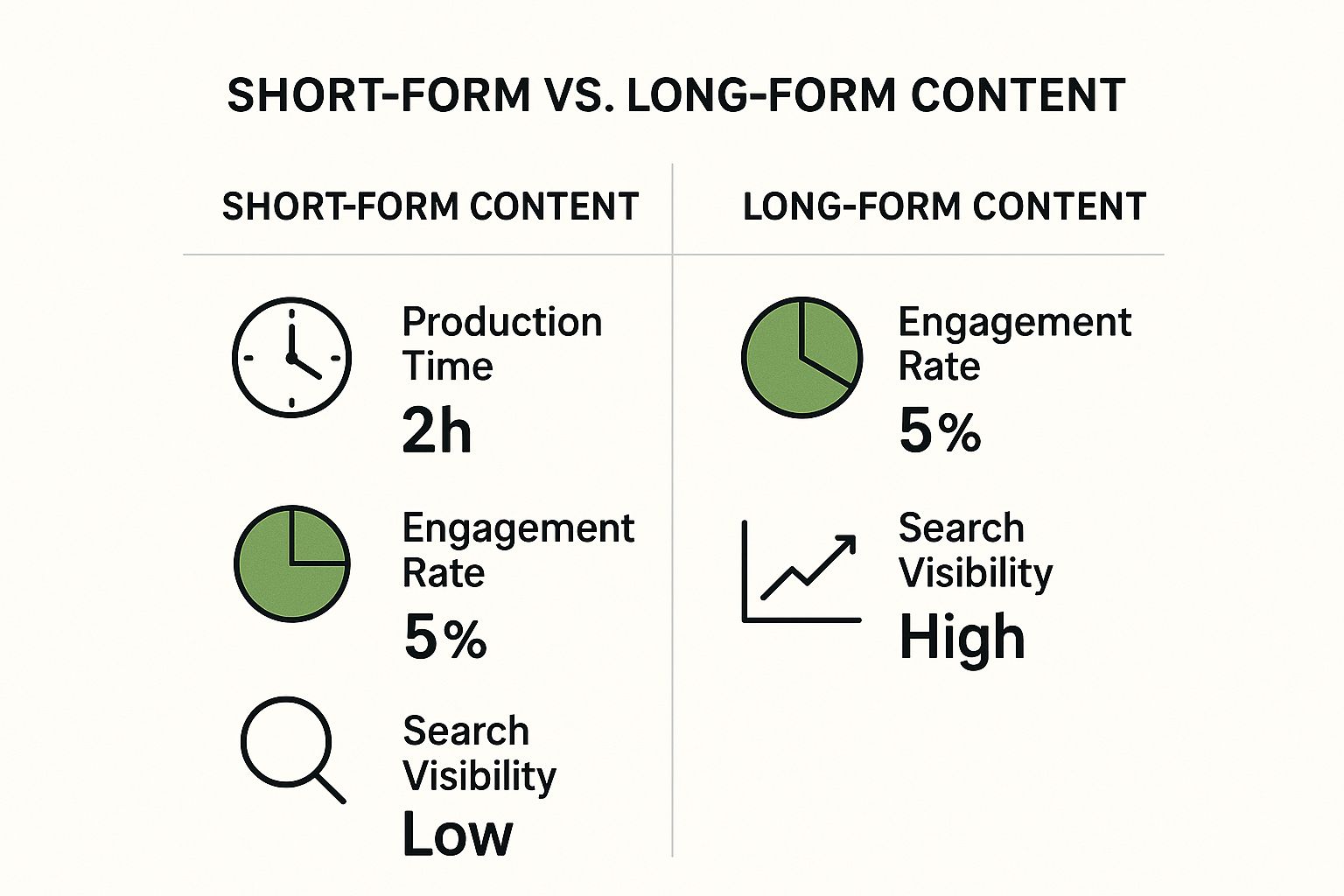Content Creation Workflow Mastery: From Chaos to Results
Why Your Content Creation Workflow Is Your Biggest Opportunity

Let's be honest: content creation can often feel chaotic. Deadlines loom, teams scramble, and it can feel like you're constantly putting out fires. This reactive approach isn't sustainable and can severely limit growth. That's where a robust content creation workflow comes in. It's the foundation for consistent, high-quality content.
The Hidden Cost of Content Chaos
Inefficient workflows have a hidden cost. Team burnout is a common result of this constant pressure. Missed deadlines also become the norm, leading to inconsistent publishing and potentially damaging your brand reputation. This reactive cycle keeps teams from focusing on strategic content that drives results. These missed opportunities can significantly impact potential growth. A disorganized workflow isn't just frustrating; it's holding your business back.
Research highlights the challenges faced by content creation workflows, especially in B2B. Only 29% of marketers with a documented content strategy find it highly effective. This struggle is often due to unclear goals (42%), content disconnected from the customer journey (39%), and a lack of data-driven insights (35%). Resource constraints also affect 54% of B2B marketers, with 45% lacking a scalable content creation model. For more insights, check out the Content Marketing Institute.
From Reactive to Strategic: The Power of a Defined Workflow
A well-defined workflow transforms chaos into a smooth, predictable process. Think of it like an assembly line: each team member has a specific role and understands their contribution. This clarity promotes accountability and streamlines the entire process. Content moves efficiently from ideation to creation, review, and finally, publication. This structure not only reduces stress but also frees up time and resources, allowing for proactive planning and execution of strategic content initiatives.
Building a Workflow That Works for You
Effective workflows aren't one-size-fits-all. They should be tailored to your team's strengths and weaknesses, your content goals, and your available resources. This means defining clear roles and responsibilities, creating an efficient approval process, and leveraging tools for collaboration and automation. The right workflow empowers your team to consistently produce high-quality content that drives measurable results, leading to increased brand visibility, stronger audience engagement, and improved ROI.
Building Your Foundation: Essential Workflow Components That Work
A well-defined content creation workflow is essential for any successful content strategy. It takes the often chaotic process of content creation and turns it into a predictable, efficient system. This section explores the key components that separate smooth-running content operations from disorganized efforts.
Defining Roles and Responsibilities
Establishing clear roles and responsibilities within your content team is paramount. This isn't about creating rigid rules, but about making sure everyone understands their contributions and who is responsible for each stage of the workflow. For instance, one team member might handle ideation and topic research, another focuses on writing and editing, and a third manages visual content and promotion. This clarity fosters accountability and minimizes confusion.
Streamlining the Approval Process
A cumbersome approval process can hinder creativity and slow down content production. Instead, design an approval workflow that enhances quality without unnecessary delays. This might involve setting clear criteria for each approval stage and assigning specific individuals to provide feedback. A tiered approval system, where different review levels are required for various content types, can also be beneficial.
Preventing Bottlenecks
Bottlenecks can disrupt any workflow. Identify potential points of congestion in your process and implement systems to address them. Make sure you have enough resources at each stage and clearly assigned tasks. This proactive approach helps maintain momentum and keeps your content calendar on track.
Mastering the Content Calendar
Your content calendar is more than just a scheduling tool; it's a strategic roadmap. For a deeper dive, check out our article on How to Master Content Planning. Set clear guidelines for how your calendar will be used and ensure everyone on the team understands its functionality. This helps align your content with your overall marketing goals and maintain a consistent publishing schedule.
Establishing Quality Standards
Maintaining consistent quality is crucial for building brand trust. Implement quality standards that uphold a high level of content without hindering creativity. This could include creating style guides, editorial guidelines, and checklists to ensure consistency across all content formats. At the same time, allow for flexibility within those standards to encourage innovation and fresh perspectives.
Leveraging Content Templates
Templates can dramatically speed up content production. Create templates for various content types, like blog posts, social media updates, and email newsletters. These templates should incorporate your brand voice and style guidelines, providing a framework for faster creation. This increased efficiency frees your team to focus on the unique aspects of each piece of content.
To better understand the effectiveness of different content formats, take a look at the comparison table below. It highlights the different components of basic and advanced workflows and how they impact overall efficiency.
Essential Workflow Components Comparison Comparison of basic vs. advanced workflow components and their impact on content production efficiency
| Component | Basic Implementation | Advanced Implementation | Impact on Efficiency |
|---|---|---|---|
| Roles & Responsibilities | Loosely defined roles, potential overlap | Clearly defined roles, documented responsibilities | Increased accountability, reduced confusion |
| Approval Process | Ad-hoc approvals, potential delays | Structured approvals, clear criteria & assigned reviewers | Faster turnaround times, improved content quality |
| Bottleneck Prevention | Reactive approach, addressing issues as they arise | Proactive approach, resource allocation planning & task management | Maintained momentum, consistent output |
| Content Calendar | Basic scheduling tool | Strategic roadmap aligned with marketing goals | Improved content strategy, consistent publishing |
| Quality Standards | Minimal guidelines | Comprehensive style guides, editorial guidelines & checklists | Enhanced brand consistency, higher quality content |
| Templates | Limited use of templates | Standardized templates for various content types | Faster content creation, increased efficiency |
As the table illustrates, a more advanced approach to workflow components can significantly boost efficiency and improve overall content quality.
The following infographic visually illustrates the differences in production time, engagement rate, and search visibility between short-form and long-form content.

As the infographic shows, short-form content has a faster turnaround, but long-form content tends to generate more engagement and higher search visibility. This knowledge can help you prioritize resources and choose the best format for your goals. Building a successful content creation workflow is an ongoing process. Continuously evaluate and refine your approach based on team feedback and performance data to ensure your workflow remains a valuable asset to your content strategy.
Strategic Planning and Smart Resource Allocation

A successful content team often depends on how well it allocates its resources. This goes beyond just the budget. It involves strategically investing time, talent, and tools where they will make the biggest difference. This section explores how top-performing content operations use smart planning and data-driven decisions to maximize their resources.
Prioritizing Content Initiatives
An effective content creation workflow starts with prioritizing projects that align with your overall business goals. This means identifying key performance indicators (KPIs) and concentrating on content initiatives that demonstrably produce results.
For example, if lead generation is your goal, prioritize content that attracts and converts potential customers. This could include gated content like ebooks, webinars, or online courses.
In-House vs. Outsourced Production
Choosing between in-house and outsourced content production is a critical resource allocation decision. In-house teams give you greater control over your brand voice and messaging.
However, outsourcing can be a more cost-effective option for specialized content or managing fluctuating workloads. The best approach depends on your specific needs, budget, and the type of content you are creating.
Data-Driven Investment Decisions
Successful content operations use data, not guesswork, to guide investment decisions. By analyzing performance metrics like website traffic, engagement rates, and conversion rates, you can understand what type of content resonates with your audience.
This data informs decisions about resource allocation, whether it's investing in new content formats, expanding distribution channels, or optimizing existing content. Cost and budget allocation are significant factors in optimizing content marketing workflows.
In 2025, 46% of B2B marketers expect to increase their content marketing budgets, 41% expect them to remain the same, and only 8% anticipate a decrease. The typical monthly cost ranges between $5,001 and $10,000, with businesses allocating between 11% and 50% of their marketing budget to content. Find more detailed statistics here.
Avoiding Resource Drains
Some activities can drain resources without providing a worthwhile return. Chasing short-lived trends or investing heavily in platforms that don’t align with your target audience can be costly mistakes.
Focus on sustainable strategies that build long-term value. You might be interested in learning How to streamline your social media workflow.
Maximizing Impact With Limited Resources
Even with limited resources, strategic planning can help maximize your impact. This might involve repurposing existing content, focusing on high-impact formats like video or interactive content, or partnering with other businesses for cross-promotional opportunities.
Smart choices and strategic prioritization can lead to significant results, even on a smaller budget.
Resource Allocation Frameworks
Several frameworks can help guide your resource allocation decisions. One approach is the "RICE" scoring model, which evaluates potential projects based on Reach, Impact, Confidence, and Effort.
Another helpful framework is the "Value vs. Complexity" matrix. This helps prioritize projects based on their potential value and how complex they are to implement. Choosing the right framework depends on your particular needs and priorities.
A strategic approach to resource allocation ensures that your content creation workflow is efficient, effective, and aligned with your business objectives. This proactive approach is key to sustainable growth and success in the competitive content landscape.
Learning From the Creator Economy Revolution
Individual creators are finding remarkable success, often outpacing big brands with innovative content workflows. This raises an important question: what can established content teams learn from the creator economy's approach to fast, efficient content production? This section explores how successful creators have built scalable processes, often outperforming complex corporate structures, and how these lessons can be applied within organizations.
Rapid Content Iteration: The Creator's Advantage
Creators are masters of rapid iteration. They test new content formats, experiment with different platforms, and quickly adjust their strategies based on audience feedback. This agile approach allows them to anticipate trends and consistently deliver engaging material. Many creators use real-time analytics tools like Google Analytics to understand what resonates with their audience. This data-driven approach helps them focus on successful content and quickly move away from what doesn't work.
Authentic Audience Engagement: Building a Community
A significant advantage creators have is their ability to build authentic relationships with their audience. They actively engage with comments, respond to messages, and create content that speaks directly to their audience's needs and interests. This creates a sense of community, increasing loyalty and boosting engagement. This direct connection provides intimate knowledge of audience preferences, allowing creators to tailor their content workflow accordingly. When making resource decisions, many creators use association-level strategic planning principles.
Maintaining Quality While Scaling Production
As creators expand their reach, they face the challenge of scaling content production without sacrificing quality. Many achieve this with efficient workflows, automation tools, and strong teams. Some creators outsource tasks like video editing or graphic design using platforms like Upwork or Fiverr to free up time for content creation. This strategic delegation allows them to focus on their strengths while maintaining a consistent flow of high-quality content. The growth of the creator economy reflects these changing workflows. Over 165 million creators have joined social media since 2020, with more than 64 million active on YouTube alone. This has led to the professionalization of content creation, with 2 in 10 creators running content-based businesses. Learn more about these statistics here.
Translating Creator Strategies to Business Contexts
While not every creator strategy fits directly into a business setting, there are valuable lessons to be learned. Businesses can adopt the creator mindset by focusing on audience engagement, embracing rapid iteration, and building a strong brand community. However, maintaining professionalism and brand consistency is critical. This means adapting creator strategies to align with brand guidelines and marketing goals. For example, running user-generated content campaigns can build community while maintaining brand voice.
Incorporating Innovation While Maintaining Professionalism
Businesses can utilize creator-inspired workflows by implementing strategies like:
- Creating Content Pillars: Focusing on core themes for the target audience.
- Repurposing Content: Adapting existing content for different platforms and formats.
- Collaborating With Influencers: Partnering with creators to reach new audiences.
- Using Agile Content Calendars: Allowing for flexibility and quick responses to trending topics.
By thoughtfully integrating these innovative approaches, businesses can enhance content operations without compromising professionalism or brand consistency. This can lead to significant improvements in audience engagement, content reach, and overall marketing effectiveness.
Tools and Technology That Actually Move the Needle

A well-defined content creation workflow requires the right tools. Choosing the wrong technology, however, can waste your budget and make your process more complicated. This section helps you identify tools that genuinely improve content operations, based on the experiences of successful content teams.
Essential Tools For A Streamlined Workflow
Several tool categories can significantly improve your content creation workflow:
Content Planning & Scheduling: Tools like Publora offer centralized content calendars, simplifying scheduling and team collaboration. This eliminates the need for multiple spreadsheets and disconnected tools, giving you a more strategic view of your content pipeline.
Writing & Editing: Grammarly, ProWritingAid, and Hemingway Editor help improve writing quality and consistency. These tools offer real-time feedback on grammar, style, and clarity, ensuring polished, professional content. AI-powered writing assistants can also help overcome writer's block and generate content ideas, but human oversight is still essential.
Visual Content Creation: Canva, Adobe Creative Suite, and Figma allow you to create engaging visuals. From social media graphics to blog post images and infographics, these platforms streamline the design process. Visual content is key for audience engagement.
SEO & Keyword Research: SEMrush, Ahrefs, and Google Keyword Planner help optimize content for search engines. These tools provide data-driven insights into relevant keywords and content trends, improving your content's visibility and reach, which is crucial for driving organic traffic and reaching a wider audience.
Collaboration & Project Management: Asana, Trello, and Slack improve team communication and project organization. These tools keep content creation on track by centralizing communication, enabling seamless file sharing and feedback. For effective social media management, check out this helpful resource: Our guide on social media management tools.
Building Your Tech Stack: A Strategic Approach
Building the right tech stack requires careful planning. Don't get distracted by the latest trends. Focus on tools that address your specific needs and integrate with your existing systems.
For example, if your team struggles with social media scheduling, invest in a platform that streamlines that process. If content quality is a concern, prioritize writing and editing tools.
Evaluating ROI and Avoiding Pitfalls
When choosing tools, consider the return on investment (ROI). Many tools offer free trials or freemium versions, allowing you to test them before committing. Analyze how much time and resources a tool can save and how it can improve your content's performance.
Avoid over-relying on tools. Technology should enhance your team’s skills and creativity, not replace them. The human element is still vital in content creation.
Measuring Tool Effectiveness: Key Metrics
Track key metrics to ensure a tool is beneficial. For content planning tools, measure the number of missed deadlines. For writing tools, track content quality changes and editing time.
For SEO tools, monitor improvements in organic traffic and search rankings. This data-driven approach shows which tools provide real value and justify their cost.
Tools ROI Analysis
Data comparing different tool categories based on cost, time savings, and workflow improvement metrics
| Tool Category | Average Monthly Cost | Time Saved (Hours/Week) | ROI Rating | Best Use Case |
|---|---|---|---|---|
| Content Planning & Scheduling | $50 - $200 | 5-10 | High | Managing complex content calendars and team collaboration |
| Writing & Editing | $10 - $30 | 2-5 | Medium | Improving writing quality and consistency |
| Visual Content Creation | $20 - $50 | 3-7 | High | Creating engaging visuals for various platforms |
| SEO & Keyword Research | $100 - $300 | 4-8 | High | Optimizing content for search engines and increasing organic traffic |
| Collaboration & Project Management | $5 - $20 per user | 2-4 | Medium | Streamlining communication and project workflows |
This table provides a general overview. Actual costs and time savings vary based on the specific tools and your team's usage. By evaluating your needs, researching options, and measuring effectiveness, you can build a tech stack that truly improves your content creation workflow.
Key Takeaways
Moving from a chaotic content creation workflow to one that’s consistently productive takes strategy. This section offers actionable takeaways based on proven strategies used by successful content teams. These insights provide a practical roadmap, realistic timelines, and measurable benchmarks for improvement.
Establish Clear Roles and Responsibilities
A well-defined workflow starts with clearly defined roles. Each team member should understand their individual responsibilities and how they contribute to the entire content creation process. This clarity promotes accountability and eliminates duplicated work. For example, assign specific people to tasks like ideation, writing, editing, creating visuals, and promotion.
Streamline The Approval Process
Bottlenecks in the approval process can drastically slow down content production. A streamlined system with clear criteria for each stage is essential. This could be a tiered approval system, where different levels of review are needed for different types of content. This maintains quality control while minimizing delays. To boost efficiency further, consider document workflow automation for managing repetitive tasks.
Leverage The Power of a Content Calendar
A content calendar is much more than a scheduling tool; it's a strategic roadmap for your content. Use it to connect your content with your overall marketing goals, and stick to a consistent publishing schedule. A well-maintained calendar also enables proactive planning. It keeps all team members informed about upcoming deadlines and content priorities.
Maintain Consistent Quality Standards
Consistent quality builds trust with your audience and reinforces their perception of your expertise. Establish clear quality standards, including style guides and editorial guidelines. These standards ensure consistency across all your content formats. Don't be too rigid though; allow room for creativity and fresh perspectives.
Utilize Templates For Efficiency
Content templates can significantly speed up content production. Create templates for different content formats like blog posts, social media updates, emails, and even video scripts. These templates can incorporate your brand voice and style guidelines. They offer a framework, allowing writers to focus on creating unique, engaging content instead of starting from scratch every time.
Integrate The Right Tools and Technologies
The right tools can dramatically improve your workflow efficiency. Select tools that meet your specific needs and work smoothly with your existing systems. For instance, project management software, content scheduling tools, and graphic design platforms can streamline your entire content creation process.
Learn From The Creator Economy
Individual creators often outperform big brands by using agile and efficient workflows. They prioritize rapid content iteration, authentic audience engagement, and using data to make informed decisions. Businesses can learn from this approach by focusing on community building, reacting quickly to feedback, and continually experimenting with new content formats and distribution channels.
Analyze, Adapt, and Improve
Building a successful content creation workflow is an ongoing process. Regularly analyze how your workflow is performing, get feedback from your team, and identify areas for improvement. Adapt your process based on data and insights. Make adjustments to optimize efficiency and maximize your content’s impact. This continual evolution ensures your workflow remains a valuable part of your content strategy.
Measuring Workflow Effectiveness: Key Metrics
Monitor key metrics to see how effective your content creation workflow is:
- Content Production Time: Track the time it takes to create different content types.
- Content Quality: Evaluate your content’s quality using metrics like engagement, shares, and conversions.
- Team Productivity: Monitor how much content your team produces each week or month.
- Resource Utilization: Analyze how effectively your budget, tools, and team's time are being used.
By tracking these metrics, you can pinpoint areas for improvement and optimize your workflow for maximum efficiency. Regularly reviewing and refining your approach is essential for staying ahead of the curve and reaching your content marketing goals.
Start optimizing your content creation workflow today with Publora. Streamline your process, enhance team collaboration, and produce high-quality content consistently. Sign up for a free 14-day trial at https://publora.com and experience the difference.
